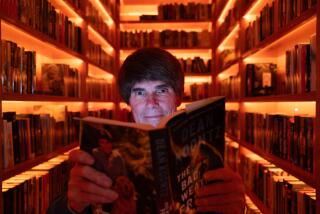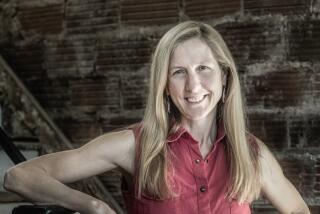‘Breath’ by Tim Winton
Breath
A Novel
Tim Winton
Farrar, Straus & Giroux: 218 pp., $23
For this reader, who has attempted surfing only once, and only long enough to be washed ashore seasick, the siren call of the waves is faint at best. But there’s a saltiness in “Breath,” Tim Winton’s newest novel, that offers an irresistible taste of oceanic communion:
“All the way down the big board chattered against the surface chop; I could hear the giggle and natter of it over the thunder behind me. When the wave drew itself up to its full height, walling a hundred yards ahead as I swept down, it seemed to create its own weather. . . . For a moment -- just a brief second of enchantment -- I felt weightless, a moth riding light. Then I leant into a turn and accelerated and the force of it slammed through my knees, thighs, bladder, and I came lofting back to the crest to feel the land breeze in my face and catch a smudge of cliffs before sailing down the line again. . . . By the wave’s last section I was styling.”
Winton often locates a transcendent wisdom in nature, letting it guide his analogies to time, space, longing and the sort of existential entrapment that comes from being born into a particular place and culture. This is the recipe for his soaring popularity in his native Australia and also the reason he has garnered an international audience. In his best moments of controlled, evocative storytelling, though, Winton’s descriptions eschew metaphor altogether and instead masterfully balance visual imagery with colloquial language. In “Breath,” the waves underpin the episodic narrative, whose most vivid moments occur at sea. It achieves that essential quality of a short novel: Its poetry becomes its imperative, its motivating and most risky venture.
“Breath” is a coming-of-age tale set in the small town of Sawyer in western Australia. It is Winton’s ninth novel -- he also has written three volumes of short stories, a handful of children’s books and two works of nonfiction -- and it displays many of his familiar themes: the affecting power of landscape; failed intimacy between men, between parents and children, between lovers; the struggles and resignations of the semirural working-class life. But “Breath” is primarily the story of an education of the body -- and of how an emotional and moral countenance is shaped by the private physical experience of desire.
Bruce Pike is the novel’s middle-aged narrator, a paramedic who, one evening on the job, has occasion to recall his boyhood. At 11, “Pikelet” acquired a wilder pal in Ivan Loon, called Loonie, the son of the town publican. Bored with swimming in the river, the two rode out to the coast one day and found themselves in the company of a group of surfers. “How strange it was to watch men do something beautiful,” Pike says of that first day he sat watching from the beach. “Something pointless and elegant, as though nobody saw or cared.”
The chopped sentence underscores the oddness of the moment. Pikelet witnesses for the first time the pure aesthetic of sport -- as an act done for its own pleasure, its own embodied beauty. This is a transformative moment for him, revealing a different kind of physicality than he’s learned from the workingmen of Sawyer. It is not the sea but the men in the sea who help him recognize his own body as a site of pleasure and spiritual experience.
Yet alongside Loonie, Pikelet is driven into the sea by the athletic challenge. Together they are convinced that surfing prowess will set them apart from the ordinary lives of their peers and their parents. Their quest for ever more extraordinary thrills takes a turn when they meet Sando -- onetime legendary surfer Billy Sanderson -- who has moved to the outskirts of Sawyer with his mysteriously embittered wife, Eva. Sando takes on the young duo as his protégés, not just training them but also bringing them along to ride remote and uncharted surf. The three form a tenuous trio, founded on a common passion for discovering their limits. For Pikelet, fear and underdeveloped strength will ultimately divide him from the other two but not in time to save him from a swell that threatens real (and sexual) violence.
When such a tightly wrought bildungsroman comes in a writer’s mid-career, one has to wonder why. “Breath” seems to address a silence at the core of Winton’s fiction. In all his stories, there is a certain quietism in the imprecision of his narration, in his willingness to let his characters hyperbolize or float along on the backs of tropes. Their authenticity lies not so much in their contradictions but in their ability to ignore those contradictions, to persevere in their attachments, to insist on surviving to the end of their unraveling lives.
It isn’t wistfulness that moves Pike to recollection, and as sensuous as the prose becomes, the memories his body stores are of a damaged life. He is ambivalent about the need to tell his story: “I’ll talk if no one’s listening,” he says at the outset. “It’s like blowing the didjeridu, cycling air through and through, doing little more than explaining yourself to your self while you’re still sane enough to do it. I’m not a nostalgic man.” The analogy of the breath propels his narration, and the narrative becomes his way of understanding the trauma of his adolescence. But what returns to Pike in spite of himself are those discrete moments of success on the waves -- moments that have shaped him, that are “completely pointless and beautiful” and in need of no explanation. *
Kathryn Crim is deputy editor of the Threepenny Review.
More to Read
Sign up for our L.A. Times Plants newsletter
At the start of each month, get a roundup of upcoming plant-related activities and events in Southern California, along with links to tips and articles you may have missed.
You may occasionally receive promotional content from the Los Angeles Times.






